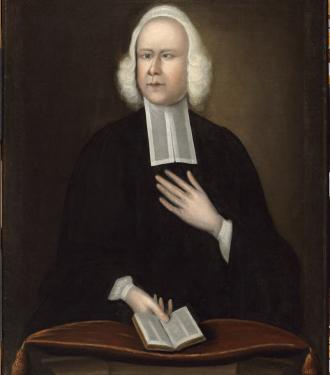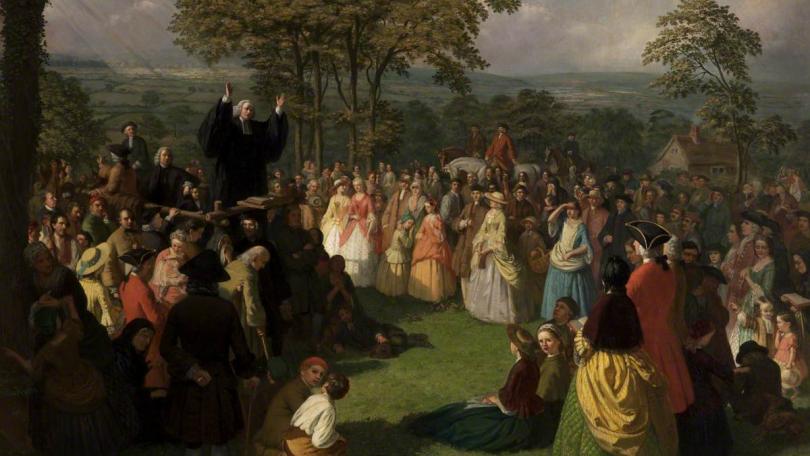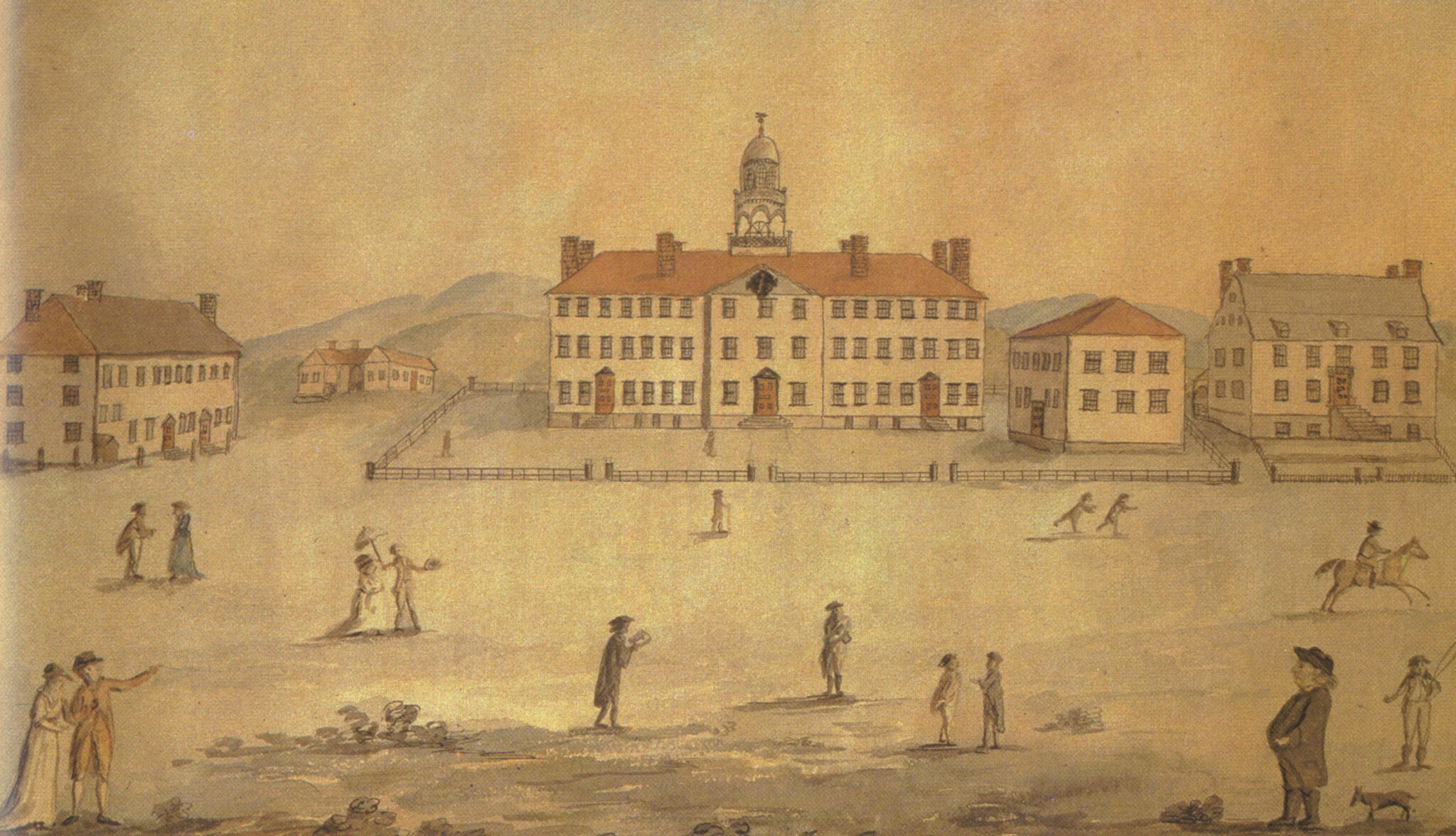Reverend George Whitefield was a religious dissenter and transatlantic evangelist.
Reverend George Whitefield is regarded as the most influential, and controversial, figure of the evangelical movement known as the Great Awakening. Whitefield spent 35 years in unrelenting ministry, traveling throughout Europe and the British colonies in North America.1 He is also a significant figure in the founding of Dartmouth College, as a fundraising consultant, an advisor to Eleazar Wheelock, and a mentor to Wheelock’s students and missionaries.
Whitefield was born in Gloucester, England, in 1714, the last of seven children whose parents operated an inn. After his father’s early death, Whitefield attended Pembroke College at Oxford University with free tuition and board in exchange for work as a servant to other students and fellows. At Oxford, Whitefield met John and Charles Wesley, and together they questioned the teachings of the Anglican Church of England.2 They were not alone, as other groups, variously called dissenters or separatists, were challenging Anglican authority.3

Portrait of George Whitefield by Joseph Badger, Harvard Art Museums

George Whitefield Preaching in Bolton, June 1750, by Thomas Whalley, Bolton Museum and Art Gallery
Nevertheless, he was ordained an Anglican deacon in 1736, and a priest in 1739. Although a strict Calvinist in his notions of moral conduct, hard work, and non-materialistic style of living, Whitefield interpreted scripture in defiance of Anglican doctrine, arguing that the mandated form of Anglican worship—strict liturgy, standardized prayers, no singing, and the solemn reading of written sermons—were not the conditions for eliciting a new birth, and that conversion was a deeply personal, emotional and spiritual transformation, rather than a public pronouncement.4 Whitefield preferred “field preaching” where his dramatic, extemporaneous oratory skills generated visible emotional displays. Thousands would gather to witness his charismatic revivals.
It was in May 1740 that Wheelock heard Whitefield, then on his second trip abroad, preach for more than two hours to a crowd of 8,000.5 Several weeks later, accompanied by fellow New Light ministers, Wheelock traveled to New York, where he met with Whitefield.6 From there, a mutually beneficial relationship grew between the two men.
Wheelock was pastor of a Congregational church in Lebanon, Colony of Connecticut, while his preaching was sought to revive other congregations and communities, and his counsel to mediate internal conflicts. His resulting prominence among the New Light clergy of New England would prove useful to George Whitefield, as Wheelock’s prodigious correspondence among local pastors and itinerant preachers assisted in the wider dissemination of Whitefield’s writings and activities.7
In turn, Whitefield, seen as a consummate self promoter who blended ministry and ambition, served as a critical role model for Wheelock’s own aspirations, while Whitefield’s renown as a radical perhaps also legitimized Wheelock’s more moderate theological perspective. Through a rather surprising friendship with Benjamin Franklin (given the latter’s opposing religious views and reputation for scandalous conduct), Whitefield was afforded access to Franklin’s publishing outlets and network of influential politicians, intellectuals, and wealthy individuals.8 Crucially, Whitefield also observed how Franklin pursued the educational initiatives that would become the University of Pennsylvania.9
In 1740, Whitefield founded the Bethesda orphanage in the Georgia colony,10 and as early as 1748-49, recorded his intention of converting it into a college.11 These plans, plus the loss of his salary under Connecticut’s anti-itinerant laws,12 influenced Wheelock’s decision to establish a school for Indians—and later, acquire a charter for a college. Whitefield counseled Wheelock on how best to gain a charter and financial support, and in 1756, Wheelock, along with Samuel Mosely and Benjamin Pomeroy, granted power of attorney to Whitefield to act on their behalf in petitioning the King for a land grant, charter and monies.13
Whitefield’s strategizing was key to the success of Samson Occom and Nathaniel Whitaker’s fateful fundraising trip to Great Britain in 1766-7, which raised the current-day equivalent of nearly $2,000,000, and established the Scottish and British trusts.14 Occom and Whitaker were guests in Whitefield’s home for several weeks, and he helped arrange accommodations throughout their stay. He personally invited Occom to preach at one of his tabernacles and facilitated his sermons in other churches and venues, while his relationships afforded productive meetings with William Legge (Lord Dartmouth) and John Thornton.15
Whitefield welcomed all faiths, social classes, and races to his revivals. In his journal, Whitefield noted the attendance of Blacks who crowded outside of churches or gathered in large fields to hear his sermons, and described their emotive responses and conversions.16 In May of 1740, he published an open letter, "To the Inhabitants of Maryland, Virginia, North and South-Carolina, concerning their Negroes," about his distress at witnessing the abuse of enslaved individuals.
Whitefield believed that many slaves would be better off dead, and was surprised to learn there weren’t more suicides. He wrote "...I think God has a quarrel with you, for your cruelty to the poor negroes. Whether it be lawful for Christians to buy slaves . . . sure I am it is sinful, when bought, to use them as bad nay worse than though they were Brutes."17;He further counseled enslavers of their Christian responsibilities to provide religious instruction.
Whitefield’s anxiety over redemption of the souls of the enslaved, or the abuse of their bodies, did not extend to their legal status as property. His Calvinist belief that lives are divinely determined and immune to human intervention meant the primary focus shifted to the afterlife and attaining a place in heaven. He understood slavery as a providentially ordained means to provide economic stability. In a 1740 letter, Whitefield described his plans for a school for Negroes outside of Philadelphia. There he would provide opportunities to cultivate the land, which would support their religious instruction and fund his greater ministry. “Young ones I intend to buy,” he wrote, “and do not despair of seeing shortly a room full of that despised generation, making melody with grace in their heart unto the Lord.”18 The school was never realized.
The Georgia colony prohibited slavery when Whitefield opened the Bethesda orphanage; nevertheless, he accepted donations and bequests of slaves and slave-produced products.19 By 1748, he was directly lobbying the Georgia trustees for slavery’s legalization as the only means to sustain Bethesda and ensure the colony’s prosperity.20
Whitefield died on September 30, 1770, in Newburyport, MA. In his will, dated several months previous, Whitefield bequeaths the Bethesda orphanage and “likewise all other buildings, lands, negroes, book, furniture and every other thing whatforever,“ to his patron Selina, Countess Dowager of Huntingdon.”21 Whitefield’s probate inventory listed 49 enslaved persons by name, consisting of 33 males and 16 females.22

An inventory of appraisement of the goods & chattels of the Reverend George Whitefield, 1771
Notes
1. Kidd, Thomas S. George Whitefield: America's Spiritual Founding Father. New Haven, CT: Yale University Press, 2014. Also see Schlenther, Boyd Stanley. "Whitefield, George (1714–1770), Calvinistic Methodist leader." Oxford Dictionary of National Biography, Oxford University Press Online.
2. Olson, Mark K. “Whitefield’s Conversion and Early Theological Formation,” in George Whitefield: Life, Context, and Legacy, edited by Geordan Hammond and David Ceri Jones. Oxford: Oxford University Press, 2016: 29-45.
3. Thompson, Andrew, ed. The Oxford History of Protestant Disssenting Traditions, Volume II: The Long Eighteenth Century c. 1689-c. 1828. Oxford: Oxford University Press, 2018.
4. Gibson, William. “Whitefield and the Church of England,” in George Whitefield: Life, Context, and Legacy, edited by Geordan Hammond and David Ceri Jones. Oxford: Oxford University Press, 2016: 46-63.
5. Eleazar Wheelock to Mrs. Sarah (Davenport) Maltby Wheelock. May 5, 1740. New Haven. Eleazar Wheelock Collection, MS-1310, Box: 1, Folder: 740305. Rauner Library Archives and Manuscripts.
6. Eleazar Wheelock to Stephen Williams. May 22, 1740. Lebanon. Eleazar Wheelock Collection MS-1310, Box: 1, Folder: 740322. Rauner Library Archives and Manuscripts.
7. Fea, John. "Wheelock's World: Letters and the Communication of Revival in Great Awakening New England." In Proceedings of the American Antiquarian Society, vol. 109, no. 1, (1999): p. 99. Cambridge: American Antiquarian Society. Also see M’Clure, David and Elijah Parish. Memoirs of the Rev. Eleazar Wheelock. Newburyport, MA: Published by Edward Little & Co. and sold at their Bookstore, Market-Square. C. Norris & Co. Printers, 1911
8. Lambert, Frank. "Subscribing for profits and piety: The friendship of Benjamin Franklin and George Whitefield." The William and Mary Quarterly 50, no. 3 (1993): 529-554.
9. Lippincott, Horace Mather. The University of Pennsylvania, Franklin's College: Being Some Account of Its Beginnings and Development, Its Customs and Traditions and Its Gifts to the Nation. Philadelphia & London: J. B. Lippincott, 1919. See pp: 13-42.
10. Whitefield, George. A Brief Account of the Rise, Progress, and Present Situation, of the Orphan House in Georgia, from January 1740/1 to January 1742/3s. London: printed by W. Strahan, 1743.
11. Choi, Peter. “Whitefield, Georgia, and the Quest for Bethesda College,” in George Whitefield: Life, Context, and Legacy, edited by Geordan Hammond and David Ceri Jones. Oxford: Oxford University Press, 2016: 224-240. 12. Bushman, Richard L. ed. The Great Awakening: Documents on the Revival of Religion, 1740-1745. Published for Omohundro Institute of Early American History and Culture. Chapel Hill, NC: The University of North Carolina Press, 1969: 58-59.
13. Eleazar Wheelock, Samuel Mosely, and Benjamin Pomeroy, to George Whitefield. Feb 25, 1756. Windham. Eleazar Wheelock Collection, MS-1310, Box: 3, Folder: 756175. Rauner Library Archives and Manuscripts.
14. Love, W. DeLoss. “The Indian Preacher in England,” in Samson Occom and the Christian Indians of New England. Boston, MA: The Pilgrim Press, 1899: 138-151. Also see M’Clure and Parish, note 8 above.
15. Correspondence between George Whitefield and Eleazar Wheelock: October 22, 1759. Ms. 759572; May 4, 1764, Ms 764304.3; and May 18, 1764, Ms. 764318.1. Eleazar Wheelock Collection, MS-1310. Rauner Library Archives and Manuscripts.
16. Whitefield, George. 1748. A letter from the Reverend Mr. Whitefield, to a reverend divine in Boston; giving a short account of his late visit to Bermuda. Philadelphia: Printed by B. Franklin and D. Hall, 1748.
17. Rev. George Whitefield To the Inhabitants of Maryland, Virginia, and North and South Carolina, concerning their Negroes. Philadelphia: Benjamin Franklin, The Pennsylvania Gazette, April 17, 1740, Numb. 592.
18. "A Letter from the Rev. Mr. George Whitefield to a Friend in London. Dated at New Brunswick, in New Jersey, April 27, 1740.” Printed by W. Strahan, 1740.
19. Tyerman, Luke. The life of the Rev. George Whitefield, 2 vols. New York: Anson D. F. Randolph, 1877, vol II: 169-170.
20. Whitefield, George. “Letter to the Honorable Trustees of Georgia, Gloucester, Dec. 6, 1748.” in The Works of the Reverend George Whitefield, M.A. London: Printed for Edward and Charles Dilly [etc.], 1771, v.2: 208-209.
21. Whitefield, George, and Richard Draper. The Last Will, and Testament, of the Late Reverend and Renowned George Whitefield. [Boston]: London printed: Boston: re-printed and sold, next to the writing school in Queen-Street, and opposite to the seat of William Vassall, Esq., 1771.
22. An inventory of appraisement of the goods & chattels of the Reverend George Whitefield at the or..., July 1, 1771. Eleazar Wheelock collection, MS-1310, 1, Box: 771101.1. Rauner Library Archives and Manuscripts.
